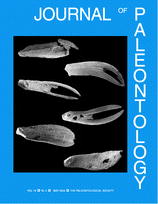New collections of fossil sponges have been recovered from Devonian to Upper Carboniferous sections of Spain. These include two new hexactinellids from Devonian rocks of northwestern Spain: the small globular protospongiid Iberospongia globulara new genus and species, and the much larger, bowl-shaped, pelicaspongiid Asturiaspongia aqualiforma new genus and species. The three specimens of Asturiaspongia n. gen. were collected from the calcareous member of the Aguión Formation, of late Emsian age, at Arnao Beach, Asturias. This member has been interpreted as a developing patch reef. The single specimen of Iberospongia n. gen. was collected from late Zlichovian (Emsian) beds of the Cortés Member of the Abadía Formation, near Polentinos, Palencia. These beds represent the beginning of the transition to deeper water that took place during the Emsian and which lasted throughout the Devonian.
Lower Carboniferous sponges have been collected from southern Spain. The hexactinellid Estrellaspongia irregulara new genus and species, is a thick-walled, basin-shaped pelicaspongiid with irregular, branched, inhalant canals and coarser irregular canals in a skeleton of irregularly oriented and spaced small hexactines. It is from late Viséan rocks of Sierra de la Estrella, near Espiel in Córdoba. The reticulosid Stereodictyum orthoplectum Finks, 1960 was collected from Viséan beds at Las Pilitas 2, Badajoz. It has a body wall of alternating layers of regularly spaced vertical and horizontal bundles of spicules in the quadrate-appearing skeleton. This is the first report of the genus from Europe and it is the oldest known occurrence of the genus.
Upper Carboniferous sponges, Bashkirian to Moscovian-Kasimovian, have been collected from northern Spain. Demosponges include: Heliospongia excavata King, 1933; Coelocladia spinosa Girty, 1908; small generically unidentifiable anthaspidellids; Haplistion Girty, 1908 sp. 1 and sp. 2; and a small fragmentary monaxonid demosponge of uncertain taxonomic assignment. Hexactinellida include the reticulosids, Stioderma perforata new species, and Stioderma Finks, 1960 sp. A, and the new amphidiscosids, Ascospongiella capdevilae new genus and species and Hadrophragmos soleniscus new genus and species. Root tufts A, B, and C are of uncertain taxonomic assignment.





